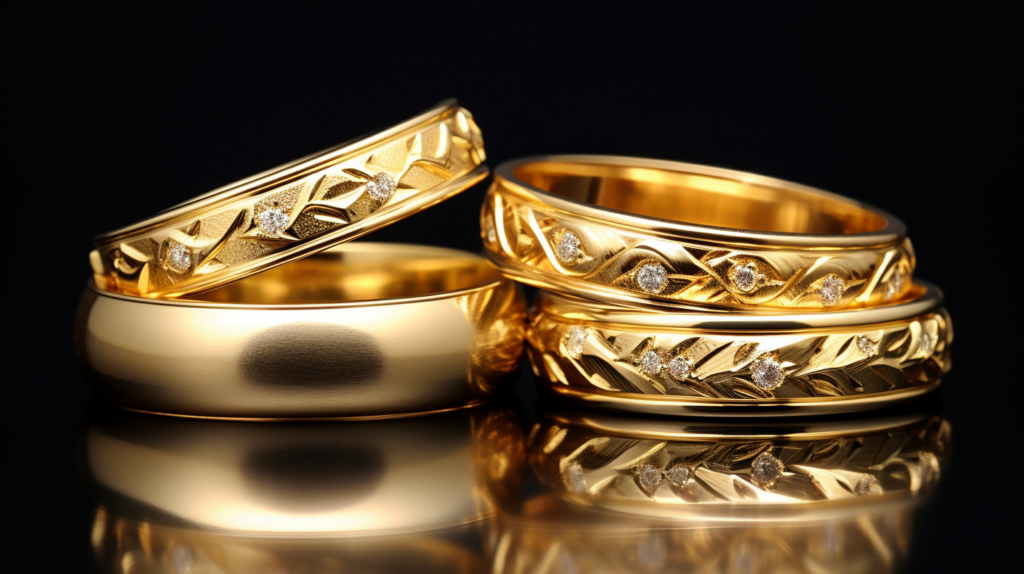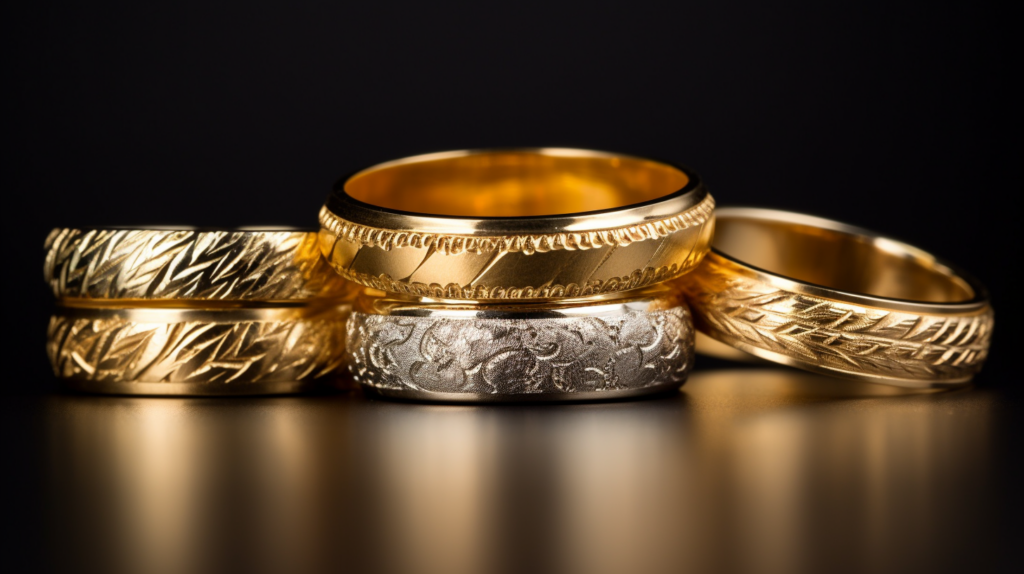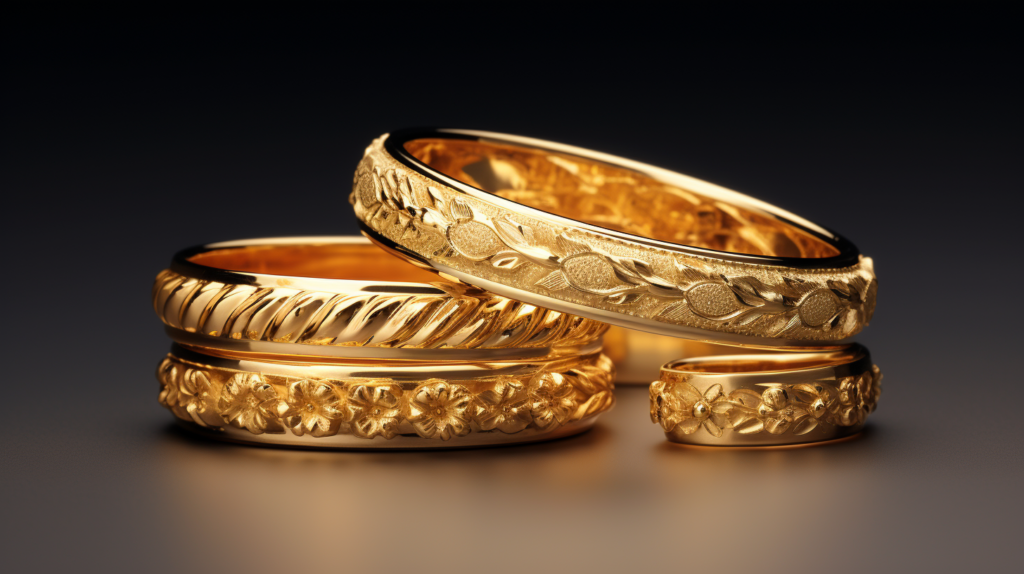The world of gold karats might seem intimidating for gold aficionados. But don’t fret! We’ll break down the mystery of 10k, 14k, 18k, and 24k gold for you. Whether you’re into buying jewelry pieces, thinking of selling a family heirloom, or investing in gold bars, understanding each karat’s gold purity content is essential.
Join us on this Guide in Comparing the Different Karats of Gold: 10k, 14k, 18k, and 24k from BrighterGuide as we delve into the pros, cons, and the rich color nuances in between. Ready to explore this precious metal? Dive right in!
Related article: Best Engagement Ring Guide
Key Takeaways
- Gold karats represent the purity of gold, with 24k being pure gold and other karats, like 10k, 14k, and 18k, indicating a blend of gold with alloy metals, influencing their strength, color, and price.
- Higher karats offer richer gold tones and increased purity but may be softer and more prone to scratches, whereas lower karats like 10k are durable and more affordable.
- While 24k gold signifies absolute purity, its softness often makes it less ideal for everyday jewelry; other karats provide a balance of beauty, durability, and affordability suitable for various jewelry needs.

What Is a Karat?
Let’s dive deeper into the world of karats, which are the units used to measure the purity of gold. When you look at a piece of gold jewelry, the gold content within is represented by its karat. Common gold purity levels you’ll come across include 10k, 14k, 18k, or 24k.
Here’s a simple breakdown: imagine a karat as 1/24th part of pure gold by weight. So, 10 karat gold signifies 41.7% gold blended with 58.3% alloy metals. On the other hand, the classic gold appearance of 24 karat gold represents pure gold without any mix of alloyed metals. Usually, the karat grade is displayed as a two-digit number followed by ‘k’ or ‘kt’. To visualize it in percentage terms, you’d place a decimal point before a three-digit figure.
Different karat grades mirror varying levels of purity. 10k gold might be on the lower end of the purity spectrum, but it’s durable and comes at an affordable price. 14k gold lies in the middle, offering a balance of beauty, durability, and affordability, making it an attractive metal for engagement rings. 18k gold, with its rich gold tone, boasts a higher gold content, making it an excellent choice for those with skin sensitivities. On the far end, we have the purest form of gold, 24k gold, which due to its soft metal nature is rarely used in wearable jewelry.
Armed with this knowledge of gold karat grades and their respective purity levels, you’re now better equipped to make an informed decision when buying or selling gold jewelry.

Karat vs. Carat: How Gold Purity is Measured
Now, let’s clear up any confusion between Karat and Carat. While the former pertains to gold purity, the latter measures the weight of diamonds and gemstones.
To reiterate, higher karats like 24k represent pure gold, while karats like 10k, 14k, and 18k indicate a mix of gold with other metals, giving the gold piece its strength and varying color shades.
How many karats is pure gold?
When we talk about 100% purity in the context of gold, we’re referring to 24 karat gold. Here’s a table to give you a clearer understanding of how various karats relate to gold purity content:
| Karat | Pure Gold Percentage |
| 10k | 41.7% |
| 14k | 58.3% |
| 18k | 75% |
| 24k | 100% |
From the table, it’s evident that as you climb the karat ladder, the percentage of gold increases. 24k gold, with its 100% gold content, is a top choice for investment purposes. But when it comes to everyday wear, many prefer the durability of 10k gold, especially for engagement rings and wedding bands. Knowing the gold to alloy ratio can guide you in choosing the ideal gold karat for your needs.
Gold Karat Scale
Venturing into the specifics, let’s discern the characteristics of 18K, 14K, and 10K gold.
Each karat, be it 18k with its high-end jewelry appeal or the popular choice of 14k, comes with its set of advantages and disadvantages. The table below contrasts the benefits and potential drawbacks of these common gold purity levels:
| Gold Purity Content | Karat | Benefits | Drawbacks |
| 10k | 41.7% gold | An affordable option with durability | Lower purity which may tarnish with time; potential allergic reactions for those with sensitive skin |
| 14k | 58.3% gold | A blend of durability and affordability; a popular choice for engagement rings and wedding bands | Not as pure as 18k; might cause skin irritations for a few |
| 18k | 75% gold | Higher purity with a rich color; more valuable | On the expensive side; softer, making it prone to scratches |
The balance between gold and alloy content greatly influences attributes like color, durability, and price point. Factors such as one’s aesthetic taste, activity level, and budget all play a part in selecting the perfect piece of gold jewelry, be it a wedding ring or a gold bracelet.
In wrapping up, understanding the distinctions between gold types, combined with personal preferences, paves the way for informed and satisfying gold purchases.

A Summary of the Differences Among Gold Types
Gold, a timeless precious metal, presents a spectrum of varieties differing in purity, durability, and price, making it a piece of jewelry treasured by many.
In the intricate jewelry industry of western countries, the purity of gold is typically gauged in karats, with 24k gold representing the purest form. Yet, the very attributes that make 24k gold the purest – its softness and susceptibility to scratches – mean it’s seldom chosen for everyday wear. In the vast majority of cases, wearable jewelry like wedding rings, engagement rings, or even family heirloom pieces usually sport 10k, 14k, or 18k gold.
Sitting at the base of the gold purity spectrum is 10k gold. Comprising 41.7% gold and 58.3% alloy materials, it stands out as an affordable option that promises durability for everyday wear and tear. Moving a notch higher, 14k gold, an excellent choice blending 58.3% gold with 41.7% alloy, offers both durability and affordability. It’s no surprise that it’s the popular type for engagement rings and high-end jewelry pieces. Yet, while its rich gold tone appeals to many, the alloyed metals within might occasionally trigger allergic reactions in those with sensitive skin.
Then, there’s the allure of 18k gold. Holding 75% gold content, it radiates with a rich color that’s especially gentle on sensitive skin, making it an attractive metal choice for those wary of skin irritations. Yet, this comes at a premium; 18k gold is pricier and, given its purity, a tad softer and more prone to scratches compared to its 14k counterpart.
When contemplating the type of gold used for a pivotal piece, such as gold engagement rings, several factors come into play. Personal decision factors like aesthetic taste, budget considerations, and skin sensitivities can greatly influence the choice. Fortunately, retailers like James Allen offer a diverse selection of gold engagement rings across various karats, catering to different tastes and needs.
Distinguishing the subtle differences between gold types is invaluable, whether you’re scouting for a new addition to your jewelry collection or contemplating a grand gesture with a wedding band.

Why Should You Buy Gold
Delving into the world of investments, gold shines brightly. With its historical worth as a backdrop, gold promises stability and has showcased consistent long-term investment growth. More than jewelry, it is real.
Why is gold still popular for buying bracelets, rings, and investment gold bars?
Golden colors have always made gold a popular jewelry choice due to its beauty and timelessness. Whether it’s the pale color of 10k or the deep yellow color of 18k, gold’s timeless hue imparts an aura of elegance and sophistication to any piece of jewelry.
Stability: The enduring value of gold offers a buffer against the turbulent waves of inflation and economic uncertainties. It’s a beacon of security during economically challenging times.
Long-term Growth: While market prices for commodities can fluctuate, gold’s track record showcases resilience. Its value not only stands the test of time but often sees appreciation, making it a worthy long-term investment.
Versatility: Gold’s malleability means it can be molded into various forms and designs, from intricate gold for rings to elaborate diamond engagement rings. The vast array of gold jewelry options caters to every aesthetic taste.
With these insights, it’s evident that whether it’s for beauty or investment, gold stands out as a wise choice. The blend of purity levels available ensures there’s something for every taste and budget.
Which Type of Gold is Best for You
With a myriad of gold options at your fingertips, making an informed decision requires a careful weighing of interests and budgetary constraints. Let’s simplify the process with a comparative glance:
| Gold Type | Purity | Durability | Affordability | Appearance |
| 10k | 41.7% pure | High | Most Affordable | Pale yellow shine |
| 14k | 58.3% pure | Medium-High | Moderate | Rich gold color |
| 18k | 75% pure | Medium | Pricier | Deep yellow tone |
| 24k | 100% pure | Low (due to soft metal nature) | Most Expensive | Bright yellow appearance |
Your personal preferences, including skin tones and sensitivities, play a pivotal role in your choice. For instance, if you have a nickel allergy or other metal allergies, 18k gold might be your safest bet. For affordable, durable jewelry for everyday wear, 10k gold may work. 14k gold, with its rich gold tone, is popular for its color, price, and durability.
Knowing these things lets you choose based on your budget, tastes, and lifestyle. There is a type of gold that is perfect for everyone, whether you are looking for something worn every day or something very fancy.

You Might Like
We propose trying out numerous gold jewelry styles to choose your favorite. Choosing the right karat gold for jewelry requires some thought. These suggestions may help you decide:
Purest Gold is 24k. Absolute purity and beautiful yellow color. However, its softness makes it less popular in jewelry.
Gold Bracelet: 18k gold is a beautiful choice for a gold bracelet. It looks better and is purer. Also good for darker skin tones.
Understanding the distinction between karat levels is crucial. Although 10k gold is the least
pure, it’s durable and inexpensive. However, 14k gold balances quality, durability, and cost.
Quality: 18k gold is highly respected. This pure, practical product is good for sensitive skin. Its rich gold color stands out.
White gold flower clusters are distinctive and suitable for white gold lovers. This pattern looks great with diamonds and scratches less.
Sources
BrighterGuide is dedicated to providing accurate and relevant information as you explore the wonderful world of diamonds and jewelry. To this end, our writers refer to primary information sources in building each article that appears on this website. These include, but are not limited to, published news articles, government portals, research papers, and more.
- Busch, E. (2021). What’s the difference between 10k, 14k, 18k, and 24k gold? Martin Busch Jewelers. https://www.martinbuschjewelers.com/blogs/news/whats-the-difference-between-10k-14k-18k-and-24k-gold
- Informer, J. (2023). Karat Gold compared: 9k, 10k, 12k, 14k, 18k, 22k, or 24k? – Jewelry Informer. Jewelry Informer. https://jewelryinformer.com/gold/karat-gold/